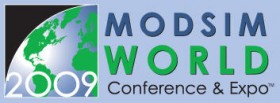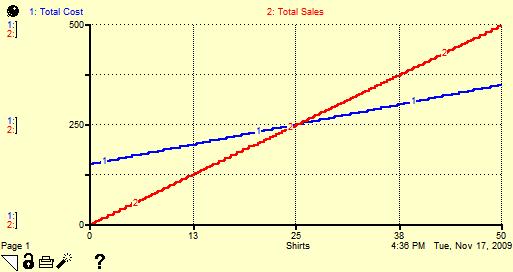Incorporating STELLA into STEM Education
 Jeremy and I recently attended the MODSIM 2009 Conference in Virginia Beach where we facilitated a pre-conference workshop with the help of Mark Clemente, a local high school science teacher.
Jeremy and I recently attended the MODSIM 2009 Conference in Virginia Beach where we facilitated a pre-conference workshop with the help of Mark Clemente, a local high school science teacher.
We’ve been working with Mark over the past year to incorporate dynamic modeling and computer-based simulation into the STEM curriculum at Ocean Lakes High School in Virginia Beach. Ocean Lakes is serving as a demonstration school for a broader initiative in Virginia to use Modeling and Simulation (MODSIM) as an engine for 21st Century workforce development.
One of our goals for the pre-conference workshop was to provide participants with STELLA models and lessons that they could use immediately in their classrooms. To attain this we put together a packet of sample lessons that would cover the spectrum of STEM education courses—Science, Technology, Engineering and Mathematics.
Science: Exploring an H1N1 flu outbreak model
Educators at all levels have found that physical activities or games can often be a good way to introduce students to STELLA models. Activities can be a lot of fun and provide a physical model for kids to make the connection with the more abstract computer-based simulation.
In our workshop, we decided to introduce a STELLA model of the H1N1 flu outbreak by first engaging the class in a simple exercise that demonstrates the spread of infectious disease using cups of water. Each student was given a cup of water and a pipette. One cup of water however, was contaminated with sodium hydroxide. We then began the process of walking around and dropping a pipette filled with liquid from our own cup into the cups of fellow students. At the end of several rounds, Mark (our teacher) put a drop of phenolphthalein solution into everyone’s cup. If the liquid turned pink, we were infected.
With a new understanding of how quickly infection can spread, the class was ready to be introduced to a STELLA model of the H1N1 flu outbreak. The core structure of the model is based on the same model that epidemiologists use to track a population through the various stages of infection including Susceptible, Exposed, Infected and Recovered (SEIR).
The simulation provided several controls for students to experiment with different policy options for controlling the spread of the virus. Along with the model, we provided a sample lesson with a set of questions to help guide students through their exploration. To download the H1N1 model and sample lesson, click here.
Technology: Inquiry-based learning with STELLA simulations
It was fascinating to watch how each student in our workshop experimented differently with the model and began asking their own set of questions. STELLA simulations and computer technology provide the perfect platform for students to learn using an inquiry-based approach. Rather than being told how something works, students can discover for themselves by exploring “what-if” scenarios and finding out what happens. For teachers, this can mean shifting from a traditional teacher role to that of a facilitator or coach, guiding students in their inquiry without knowing in advance the path they’ll choose.
Engineering/Physics: The Pendulum Story
 Another STELLA model that we introduced to workshop participants was one that Mark and I modified for the Physics Flexbook project earlier this year. The original version was developed by Diana Fisher in her book Lessons in Mathematics: A Dynamic Approach. The model provides a practice field for learning how the variables of simple harmonic motion are related. Controls in the simulation allow you to explore what effect, if any, string length, initial displacement, and pendulum ball mass have on the amplitude, period, and frequency of the pendulum’s motion. To download the pendulum model and sample lesson, click here.
Another STELLA model that we introduced to workshop participants was one that Mark and I modified for the Physics Flexbook project earlier this year. The original version was developed by Diana Fisher in her book Lessons in Mathematics: A Dynamic Approach. The model provides a practice field for learning how the variables of simple harmonic motion are related. Controls in the simulation allow you to explore what effect, if any, string length, initial displacement, and pendulum ball mass have on the amplitude, period, and frequency of the pendulum’s motion. To download the pendulum model and sample lesson, click here.
Mathematics: Algebra Word Problems
You may remember from your own experience in math class that word problems typically give students a lot of trouble! It is especially difficult to understand what is important in the problem and how to translate words into mathematical equations. STELLA can help by allowing students to create a visual representation of the problem and making it easier to understand the symbolic representation.
For the workshop, we used the following word problem as an example of a typical Algebra I assignment:
Imagine your class is going to try to raise $400 by making school T-shirts. There is a $150 set-up charge for the T-shirt design that you have designed. Once the design is set, it costs $4 for each T-shirt. You feel it is possible to charge $10 for each T-shirt. How many T-shirts do you have to sell before you break even, i.e., make enough money to cover your costs?
Together we created a STELLA model that provided a visual representation of the word problem and gave everyone some hands-on experience building models from scratch. It also inspired some participants to think about ways they could expand or change the model to answer additional questions that weren’t part of their immediate assignment.

To download the T-shirt model and lesson, click here.
We’d love to expand our library of STELLA lessons and models so that we can share them with teachers. If you’ve got any ideas of things you’d like to try in your classroom, please feel free to contact us – we’re here to help!